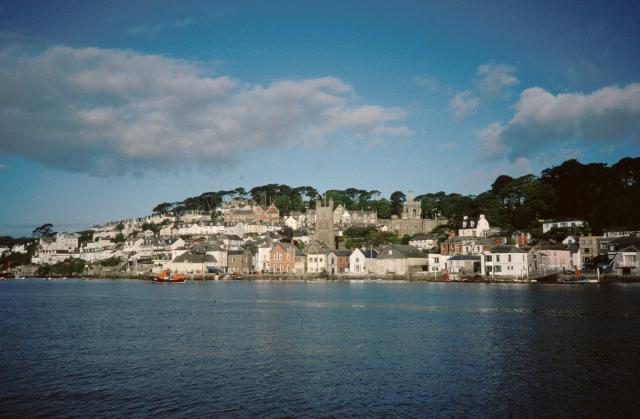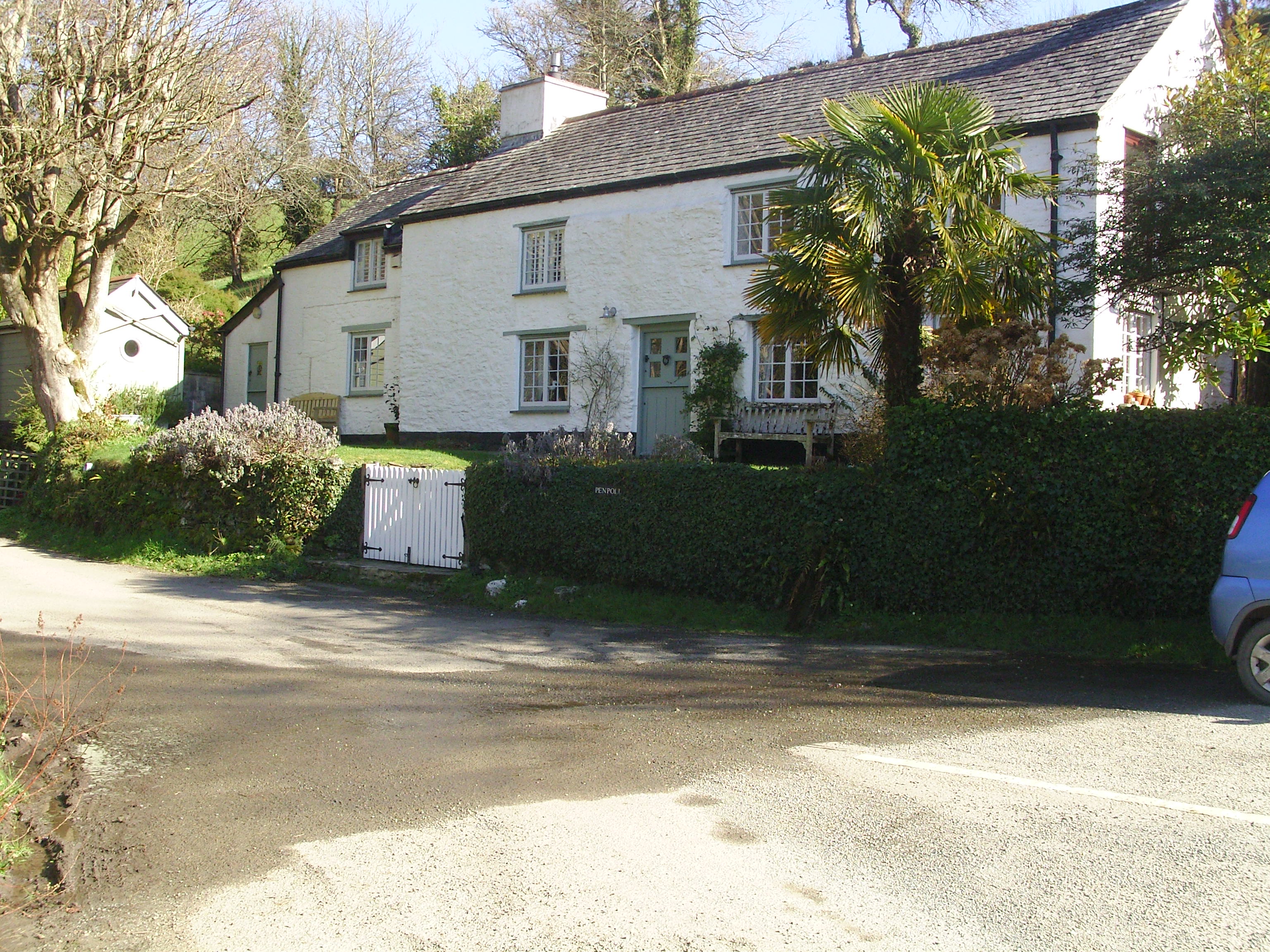|
St Sampson, Cornwall
St Sampson is a civil parish in mid-Cornwall, England, United Kingdom. The population at the 2011 census was 260. Formally known as the parish of Golant (Golant is a small village on the west bank of the Fowey river) the parish is bounded on the north by Lanlivery, on the east by the river Fowey which separates it from St Winnow, St Veep and Lanteglos-by-Fowey, on the south by Fowey, and on the west by Tywardreath. The small church has a holy well by the south porch and is dedicated to St Sampson, by whose name the parish is usually known. The church was probably all built at the same time and was dedicated in 1509. There is a low western tower. Features of interest include bench ends made into a pulpit and a sculpture of the head of Christ (perhaps Italian). Penquite House near Golant was designed by George Wightwick George Wightwick (26 August 1802 – 9 July 1872) was a British architect based in Plymouth, and possibly the first architectural journalist. In additi ... [...More Info...] [...Related Items...] OR: [Wikipedia] [Google] [Baidu] |
Saint Sampson's Church, Golant - Geograph
In religious belief, a saint is a person who is recognized as having an exceptional degree of holiness, likeness, or closeness to God. However, the use of the term ''saint'' depends on the context and denomination. In Catholic, Eastern Orthodox, Anglican, Oriental Orthodox, and Lutheran doctrine, all of their faithful deceased in Heaven are considered to be saints, but some are considered worthy of greater honor or emulation. Official ecclesiastical recognition, and consequently a public cult of veneration, is conferred on some denominational saints through the process of canonization in the Catholic Church or glorification in the Eastern Orthodox Church after their approval. While the English word ''saint'' originated in Christianity, historians of religion tend to use the appellation "in a more general way to refer to the state of special holiness that many religions attribute to certain people", referring to the Jewish tzadik, the Islamic walī, the Hindu rishi or Sikh gur ... [...More Info...] [...Related Items...] OR: [Wikipedia] [Google] [Baidu] |
Fowey
Fowey ( ; kw, Fowydh, meaning 'Beech Trees') is a port town and civil parish at the mouth of the River Fowey in south Cornwall, England, United Kingdom. The town has been in existence since well before the Norman invasion, with the local church first established some time in the 7th century; the estuary of the River Fowey forms a natural harbour which enabled the town to become an important trading centre. Privateers also made use of the sheltered harbourage. The Lostwithiel and Fowey Railway brought China clay here for export. History Early history The Domesday Book survey at the end of the 11th century records manors at Penventinue and Trenant, and a priory was soon established nearby at Tywardreath. the prior granted a charter to people living in Fowey itself. This medieval town ran from a north gate near Boddinick Passage to a south gate at what is now Lostwithiel Street; the town extended a little way up the hillside and was bounded on the other side by the river where ... [...More Info...] [...Related Items...] OR: [Wikipedia] [Google] [Baidu] |
Villages In Cornwall
A village is a clustered human settlement or community, larger than a hamlet but smaller than a town (although the word is often used to describe both hamlets and smaller towns), with a population typically ranging from a few hundred to a few thousand. Though villages are often located in rural areas, the term urban village is also applied to certain urban neighborhoods. Villages are normally permanent, with fixed dwellings; however, transient villages can occur. Further, the dwellings of a village are fairly close to one another, not scattered broadly over the landscape, as a dispersed settlement. In the past, villages were a usual form of community for societies that practice subsistence agriculture, and also for some non-agricultural societies. In Great Britain, a hamlet earned the right to be called a village when it built a church. [...More Info...] [...Related Items...] OR: [Wikipedia] [Google] [Baidu] |
George Wightwick
George Wightwick (26 August 1802 – 9 July 1872) was a British architect based in Plymouth, and possibly the first architectural journalist. In addition to his architectural practice, he developed his skills and the market for architectural journalism. His views of church design disagreed with those of churchmen with power to commission new churches and this work dropped off after he published his ideas in ''Weale's Quarterly papers on Architecture'' in 1844/5. He married twice but had no children and died at Portishead on 9 July 1872. Life and work Early years Wightwick was born in Alyn Bank, near Mold, Flintshire, Wales and trained in London under Edward Lapidge. Following a year of travel and study in Italy, he published ''Select Views of Roman Antiquities'' (1828) . Plymouth In the late 1820s, Wightwick moved to Plymouth, and worked with John Foulston, succeeding to Foulston's practice after six months. From then until 1852, when he retired to Bristol, he completed m ... [...More Info...] [...Related Items...] OR: [Wikipedia] [Google] [Baidu] |
Samson Of Dol
Samson of Dol (also Samsun; born late 5th century) was a Cornish saint, who is also counted among the seven founder saints of Brittany with Pol Aurelian, Tugdual or Tudwal, Brieuc, Malo, Patern (Paternus) and Corentin. Born in southern Wales, he died in Dol-de-Bretagne, a small town in north Brittany. Life The primary source for his biography is the ''Vita Sancti Samsonis'', written sometime between 610 and 820 and clearly based on earlier materials. It gives useful details of contacts between churchmen in Britain, Ireland and Brittany. Samson was the son of Amon of Demetia and Anna of Gwent. His father's brother married his mother's sister so that their son Maglor was Samson's cousin twice over. Due to a prophecy concerning his birth his parents placed him under the care of Illtud, Abbot of Llantwit Fawr, where he was raised and educated. Samson later sought a greater austerity than his school provided, and so moved to Llantwit's daughter house, the island monastery ... [...More Info...] [...Related Items...] OR: [Wikipedia] [Google] [Baidu] |
St Sampson's Church, Golant
St Sampson's Church is the Church of England parish church of the village of Golant, Cornwall, England, United Kingdom; it is dedicated to St Sampson of Dol. St Sampson's features in Simon Jenkins's book ''England's Thousand Best Churches'', in which it is described as "warm and welcoming". The poet John Betjeman remarked that its pews were "extremely uncomfortable, recall the fidgets of Gus and Flora in '' Ravenshoe''". It is open every day of the year, holds services every Sunday and evening prayer every Thursday evening at 6 o’clock. Its choir sings every 2nd and 4th Sunday of the month. History Saint Samson of Dol Although Cornwall has more saints than any other county in the UK, Saint Sampson is one of the better known ones. He sometimes stayed in Golant while travelling to Brittany and became the archbishop of Dol. Many Cornish saints travelling from Ireland to France ''via'' the south Cornish coast stopped on the way (sometimes in or near the village). There is now a ... [...More Info...] [...Related Items...] OR: [Wikipedia] [Google] [Baidu] |
Tywardreath
Tywardreath (; kw, Ti War Dreth, meaning "House on the Beach" (or Strand)) is a small hilltop village on the south coast of Cornwall, England, United Kingdom, about north west of Fowey. It is located in a sheltered spot overlooking a silted up estuary opposite Par and near the beach of Par Sands. It is on the Saints' Way path. Tywardreath was featured by Daphne du Maurier in her novel ''The House on the Strand''. Although this was a fictional tale of drug-induced time-travel, the history and geography of the area was carefully researched by du Maurier, who lived in a house called Kilmarth ( kw, Kilmergh, meaning ''horses' ridge''), to the south. It also appears in her 1946 novel The King’s General. The seal of the borough of Tywardreath was a Shield of Arms, a saltire between four fleurs-de-lis, with the legend "Tywardreath". The arms are derived from those of the priory: the saltire for St Andrew, the patron of the priory and parish church; the fleur-de-lis for the Frenc ... [...More Info...] [...Related Items...] OR: [Wikipedia] [Google] [Baidu] |
Lanteglos-by-Fowey
Lanteglos (Old kw, Nant Eglos, meaning ''church valley'') is a coastal civil parish in south Cornwall, England, United Kingdom. It is on the east side of the tidal estuary of the River Fowey which separates it from the town and civil parish of Fowey. The South West Coast Path runs along the southern coasts of the parish and much of the southern part of the parish lies in the Polruan to Polperro Site of Special Scientific Interest managed by the National Trust. Geography To the north, Lanteglos-by-Fowey is bounded by the parish of St Veep, to the east by the parish of Polperro, and to the south by the sea. The parish is in the Liskeard Registration District and the population in the 2001 and 2011 census was 994. Penpol Creek forms part of the northern boundary. The parish church of Saint Wyllow is at Churchtown hamlet () just over a mile (2 km) to the south. St Saviour church (a chapel-of-ease of the parish church) is in Polruan, the largest settlement in the parish. The ... [...More Info...] [...Related Items...] OR: [Wikipedia] [Google] [Baidu] |
St Veep
St Veep ( kw, Sen Vip) is a civil parish in Cornwall, England, United Kingdom, situated above the east bank of the River Fowey about three miles (5 km) south-east of Lostwithiel. It is bordered by the parishes of St Winnow to the north-west, Boconnoc to the north, Lanreath to the east Polperro to the south-east and Lanteglos to the south. The River Fowey forms its western boundary. The parish is named after Saint Veep of whom little is known (not even whether the saint was male or female). Part of the village of Lerryn is in St Veep parish. The hamlets of Cliff (), Higher Penpol (), Middle Penpol and Lower Penpol () are all within the parish. History The parish church was originally dedicated to Saint Veep, but when it was rebuilt in 1336 it was rededicated to Saint Quiricus and Saint Julietta. Following the Prayer Book Rebellion of 1549, a number of well-known Cornish figures and priests were murdered or hanged in Cornwall. These included Richard Bennet, vicar of St ... [...More Info...] [...Related Items...] OR: [Wikipedia] [Google] [Baidu] |
St Winnow
St Winnow ( kw, Sen Gwynnek) is a civil parish in Cornwall, England, United Kingdom. Its name may be connected with either that of Saint Winnoc or Saint Winwaloe. It has a population of 304, which had increased to 328 at the 2011 census. The church town is on the east bank of the River Fowey south of Lostwithiel. Part of the village of Lerryn lies within the parish as does the Chapel of St Nectan. The Redlake Meadows & Hoggs Moor, a Site of Special Scientific Interest is also in the parish. History and antiquities St Winnow was recorded in the Domesday Book of 1086 as San Winnuc. In 1644-45, some ninety people from the parish died of the plague: only four were soldiers but a campaign of the Civil War was going on at the time. Andrew Langdon (1996) records three stone crosses in the parish. A cross found at Higher Coombe in 1903 was afterwards erected at St Nectan's chapel. A cross from Lanlivery was made into the upper section of "The Monument" on Druids Hill. It wa ... [...More Info...] [...Related Items...] OR: [Wikipedia] [Google] [Baidu] |







